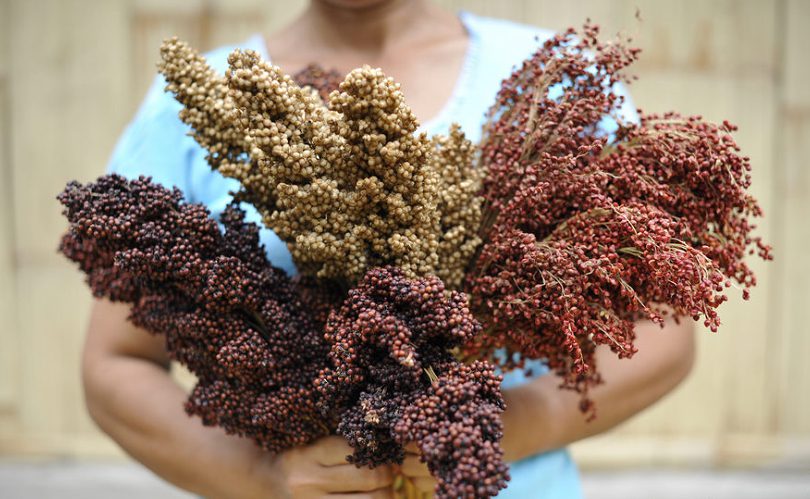CAN WE AFFORD FOOD UNIFORMITY?

-
Date:
17 Oct 2019 -
Author:
KEHATI
The date of the 2019 World Food Day is October 16. “Agriculture and Food Industry Technology Towards Indonesia’s World Food Barn in 2045” or “Our actions are our future, healthy diets #zerohungerworld” is the topic for this year’s World Food Day.
Through the use of industrial technology, Indonesia’s agricultural and food development will be accelerated in order to transform Indonesia into a global food farm. Prof. Dr. Emil Salim, the founder of the Kehati Foundation, made a variety of statements during the talk show “Diversity as the Answer to Food Sources For the Future,” which was hosted by the Indonesian Biodiversity Foundation (Kehati) on July 29, 2019.
“The problem is how to persuade the cabinet ministers that infrastructure is not just for people, but also takes care of ecosystems and animals. Can we produce quality food while preserving biodiversity? Can Cianjur produce more rice while also producing a wider variety of other foods like corn, bananas, sweet potatoes, sago, cassava, and sorghum? Can Indonesia benefit from its biodiversity?” Emily Salim stated.
He claims that in 1965 Indonesia went through an economic and political crisis that caused significant inflation and skyrocketing food costs, particularly for rice. Then, with the exception of eastern Indonesia, a program was established that provided civil servants with cash and rice rations nationwide. As a result, authorities in eastern Indonesia objected and felt unfairly treated. This was addressed by encouraging a policy to boost rice production. This rice policy, however, received a number of objections.
At that time, government laws emphasized self-sufficiency in rice-based foods. The archipelago had a flood of rice, which caused other food sources to vanish. Emil Salim took part in the United Nations conference on the environment and people in 1972, which resulted in the Stockholm Declaration. All imply that environmental security is necessary. What is the position of the food development that requires land if there is a call to cease clearing forests? This is a thought that won’t go away.
But then Indira Gandhi, the prime minister of India, showed in and declared that improving the environment was essential to ending poverty. Water, cleanliness, nutrition, and other non-economic issues make up the environment in question. Indira Gandhi used the language of the surroundings to discuss the poverty in her country, which piqued Emil Salim’s curiosity.
Emil Salim discovered upon his return to Jakarta that Indonesia is diverse and that it presents itself with multiplicity and diversity. The more I think about it, homogeneity doesn’t work in Indonesia,” he admitted. Indonesia benefits from its diversity.
Indonesia defies the idea of uniformity. Emil Salim, then the minister of the environment, began to believe more and more strongly in the need of diversity above specialization and homogeneity in 1978. It turned out that the economic development at the time, which gave rice top priority, was incorrect.
“But after working for years as a traditional economist, I just started to believe in it,” Emil stated.
Changing the policy paradigm from uniform to diverse
According to data compiled by the Central Bureau of Statistics (BPS), just 53.5 percent of the population’s basic diet in 1954 was made up of rice. Cassava made up 22.26 percent of the total, followed by corn (18.9) and tubers (4.99 percent). The consumption of staple foods saw a significant change in 1981. The percentages for rice (81.1%), cassava (10.2%), and corn (7.82%) are shown. Only 8.83 percent of cassava and 3.1% of corn were consumed in 1999. By the beginning of 2010, rice was the only staple meal still being consumed. The consumption of rice has risen once more after declining in 2012.
If it is complemented by good agricultural and food governance, the dream of becoming the world’s food storehouse in 2045 is unquestionably very likely to come true. Not only should regulatory policies favor farmers, but they should also enhance the possibilities for diversity in food supplies, sustainable technologies, and transparent government. Ten proposals can be used as a guide for the upcoming administration or cabinet to help achieve this goal of making Indonesia a global granary and creating room for the biodiversity of indigenous food sources to be more productive.
The ten proposals are as follows:
1. Restore the food philosophy of the Archipelago, which is based on the variety of biological resources and regional culture.
2. Integrating food from the archipelago into national programs
3. Add national priority programs, the national budgeting system, and national food diversity to the National Medium-Term Development Plan (RPJMN).
4. Create a national goal to decrease the consumption of rice as a source of carbs and switch it out for other local food options.
5. Align food policies with the Sustainable Development Goals (SDGs), particularly goal two, as well as health, biodiversity, and climate change
6. Creating communal food reserves (CPM), as per Article 33 of Law Number 18 of 2012 Concerning Food, where the community has the broadest rights and possibilities to do so
7. Create a system for regional governments and activists to get rewards, including incentives, for protecting the food in the Archipelago.
8. Establish the government’s priority as accelerating the archipelago’s food consumption in accordance with the Food Law by using a consumer movement (women and children) and a culinary and cultural approach.
9. Creating an ecosystem that is favorable for the development of young farmers in the growing Archipelago food
10. By defending the rights of seed conservationists/farmers and indigenous peoples as supervisors, strengthen seed development projects derived from Indonesian biodiversity toward Indonesia’s seed and food sovereignty.
(Puji Sumedi Hanggarawati)
